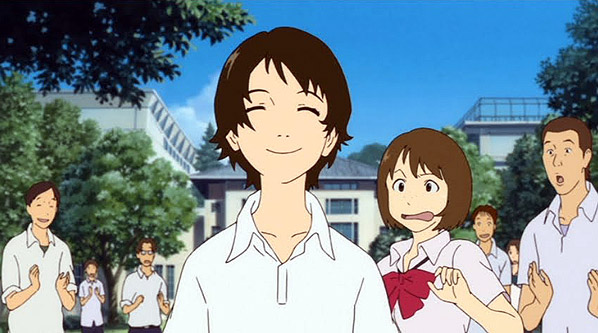
The Girl Who Leapt Through Time

THE GIRL WHO LEAPT THROUGH TIME (MOVIE)
Madhouse
Original release: July 15th, 2006
Running time: 98 minutes
Country of origin: Japan
Original language: Japanese
Director: Mamoru Hosoda
Writers: Satoko Okudera based on novel by Yasutaka Tsutsui
Voice cast: Emily Hirst, Saffron Henderson, Shannon Chan-Kent, Andrew Francis

Although I can’t see into the minds of everyone, I’m pretty sure most of us finish the average day with a number of small regrets. I certainly do. This doesn’t normally concern anything too significant; it would be nice to be able to slightly re-phrase something I said to someone, not forget to re-charge my phone before going to work or perhaps get somewhere a little bit earlier than I did. Just a few small things I wish I could amend more to my liking. In fact, I’m pretty sure – if you’re anything like me anyway – that we don’t merely have these regrets, but have also fantasised about having the ability to actually make these amendments whenever we deem necessary. Would everything be perfect all of a sudden?
Living out this common fantasy under the cloak of science fiction is what Mamoru Hosoda brought to the screen in his animated feature The Girl Who Leapt Through Time. What seventeen-year-old Makoto Konno (Emily Hirst) doesn’t know is that making mistakes is inevitable, with or without leaping through time. While the film’s an interesting mixture of science fiction and a romance – perhaps an almost cheeky attempt to bring boyfriends with girlfriends into the theatres – it’s more importantly an exploration of causality with a fictional device that enables us to observe cause and effect with slight modifications.
When Makoto stumbles (literally) upon a strange device that ‘charges up’ her body with the ability to leap back in time, she begins jumping frequently to create that perfect world that cannot be. She’s never late anymore, her grades improve and she no longer has to have awkward conversations as she can just predict and then avoid all things she doesn’t want to face. The film very smartly makes the point that avoiding one mistake will inevitably lead to another at a later point. Makoto soon finds herself in a maze where she has created problems by trying to avoid them.

The Girl Who Leapt Through Time observes these consequences in a coming of age story in which the science fiction element has a very practical purpose – perhaps it’s so practical that sci-fi nerds will not find enough to their satisfaction. However, I still found the idea of an ‘organic’ time travelling device that can enable the human body to time leap without having to sit inside the DeLorean a fascinating concept.
The film’s quite an intriguing hybrid of these different genres, but the point needs to be made that it functions as a romance story more than it does as science fiction. As such though, it’s really very good. It’s a loose sequel to Yasutaka Tsutsui’s novel of the same name, so if you wonder how Makoto’s aunt Kazuki (Saffron Henderson) knows so much about how time travel works, the answer is in the novel. Makoto is a likable teenager who remains just as likable – and just as flawed – even with the aid of time travel. Her first romance is complicated and she has no way of making it less so. Time travel can’t do that, but maybe a little bit of honesty can.


Arpad Lukacs
Arpad is a Film Studies graduate and passionate photographer (he picked up the camera and started taking stills just as he began his studies of moving pictures). He admires directors that can tell a story first of all in images. More or less inevitably, Brian De Palma has become Aprad’s favourite filmmaker.
Then there’s Arpad’s interest in anime. He was just a boy when he saw Nausicaä of the Valley of the Wind on an old VHS and was hypnotised by the story of friendship, devotion and sacrifice. He still marvels at the uncompromising and courageous storytelling in Japanese anime, and wonders about the western audience with its ever growing appetite for “Japanemation”.
Have a look at Arpad's photography site, and you can follow him on Twitter @arpadlukacs.
© 2022 STATIC MASS EMPORIUM . All Rights Reserved. Powered by METATEMPUS | creative.timeless.personal. | DISCLAIMER, TERMS & CONDITIONS
HOME | ABOUT | CONTACT | TWITTER | GOOGLE+ | FACEBOOK | TUMBLR | YOUTUBE | RSS FEED
CINEMA REVIEWS | BLU-RAY & DVD | THE EMPORIUM | DOCUMENTARIES | WORLD CINEMA | CULT MOVIES | INDIAN CINEMA | EARLY CINEMA
MOVIE CLASSICS | DECONSTRUCTING CINEMA | SOUNDTRACKS | INTERVIEWS | THE DIRECTOR’S CHAIR | JAPANESE CINEMA





